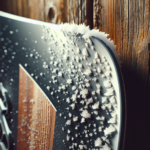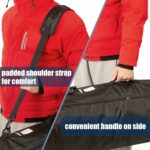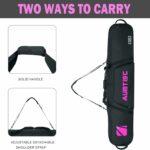If you’re an avid snowboarder, keeping your gear in pristine condition is a matter of pride. Yet, occasionally, you’ll find rust creeping up on the edges of your snowboard. Before it leads to more serious damage, this article will guide you on tackling this challenge head-on. Ridding your snowboard’s edge of unwanted rust not only extends its longevity, but it keeps you shredding the slopes in style. Read on to learn the easiest and most effective ways to remove rust from your snowboard’s edges.
Understanding The Snowboard Rust Issue
Before we delve into fixing your rusty snowboard issue, let’s try to understand what rust actually is.
Defining what rust is
Rust is a form of iron oxide that occurs when iron or an alloy that contains iron, like steel, is exposed to oxygen and moisture for a prolonged period. You might see this reddish-brown flaky substance commonly on iron and its alloys, including your snowboard’s metal edges.
Explaining how rust can affect a snowboard
Rust on a snowboard doesn’t just make it look old and neglected—it also significantly affects its performance. The edges of your board are crucial for controlling your speed and direction as you glide down the slopes. When these edges get coated in rust, they become dull and less responsive. In turn, this can interfere with your ability to carve, turn, or stop effectively.
Understanding why rust forms on the edges of a snowboard
Rust commonly forms on snowboard edges because they are typically made from steel, an iron alloy. When your snowy adventures end, the snowboard often remains wet for an extended period, and combined with oxygen in the air, rust starts to form. Your board might also have microscopic cracks where water can seep in, and that’s where rust starts acting up.
Identifying Rust on Snowboard Edges
Being able to identify rust is the first step to dealing with it.
Characteristics of rust on snowboards
Rust appears as a reddish-brown flaky crust on the metal parts of your snowboard. It could be a small speck on the side or a more pervasive coating around the edges. Additionally, rust might make the metal feel rough to the touch.
Differentiating between rust and other types of stains or damage
Not every discoloration on your snowboard is necessarily rust. Dirt, scuff marks from rocks, or tree sap can also leave marks on your board. However, unlike these, rust has a distinctive color, usually reddish-brown, and a crusty texture that sets it apart.
Evaluating the extent of rust damage
Not all rust is created equal. Some rust might only be surface deep and relatively easy to handle. However, if the rust has been allowed to sit for too long, it might have eaten deeper into the metal, causing pitting or warping, which would make remediation more challenging.
The Importance of Rust Removal for Snowboard Performance
Rust isn’t just an aesthetic problem for your board—it significantly impacts your snowboard’s performance and lifespan.
Influence of rust on snowboard speed
Rusted edges can affect your snowboard’s speed. Rust creates friction, which can slow you down as you try to glide effortlessly down the slopes.
Impact of rust on turning and maneuverability
Perhaps even more important than speed, rust also affects the board’s turning and maneuverability as it hinders the smooth functioning of the edges. With rusted edges, your snowboard might respond slower to your movements, making turns and carving harder.
Effects of rust on snowboard lifespan
If rust is left unchecked, it can eventually lead to structural damage and irreparable harm as it eats away at the metal, thereby reducing the lifespan of your snowboard significantly.
Safety Precautions Before Dealing With Rust
Before you don your superhero cape and tackle the rust, some safety precautions are worth considering.
Hazards of dealing with rust
Cleaning rust involves sharp tools and potent chemical solutions, which can be hazardous if not handled correctly. Additionally, rust particles can cause skin and eye irritations.
Safety gear to wear when removing rust
When removing rust, it’s recommended to wear gloves to protect your hands from both the rust and the cleaning solution. Safety glasses or goggles can protect your eyes from rust particles or splashes of the rust remover.
Environmental considerations when disposing rust particles
Lastly, remember that rust particles and used cleaning solutions should be properly disposed of, not washed down the drain. The particles can damage pipes, and the cleaning solution may be toxic to the environment.
Choosing The Right Tools and Materials for Rust Removal
A proper rust removal session requires the correct tools and materials.
Recommended rust removal solutions
There are various rust removal solutions to choose from, depending on the extent of the rust. For lighter rust, a mixture of lemon juice and baking soda might work—while for more extensive rust, you might need a specialized rust remover.
Effective tools for scraping rust
To scrape off the rust, a tool as simple as an old toothbrush might be sufficient. If the rust is more stubborn, consider using a wire brush or a specialized edge tool.
Beneficial materials for rust prevention
Once the rust is gone, using a silicon-based lubricant can help keep moisture at bay and prevent future rust. A good-quality snowboard wax can also create a protective barrier.
Step-by-Step Instructions for Rust Removal
Now it’s time for a little elbow grease.
Initial snowboard cleaning
Before you start dealing with the rust, give your snowboard a good clean. Wipe off any loose dirt and dry it well.
Application of rust remover
Next, apply your rust remover of choice to the rusted areas. Give it at least a few minutes to work its magic, but make sure to check the instructions on the packaging.
Rust scrubbing and scraping process
Scrub the edges gently yet firmly using the scrubbing tool. Take care not to damage the board itself, focusing only on the rusted areas.
Wiping off the rust and cleaner residues
Once you’ve removed all visible rust, rinse off the cleaner, and make sure no residues are left on the board. Dry it thoroughly before storing it away.
Polishing and Finishing After Rust Removal
Polishing and finishing are the cherries on top of the rust removal job, keeping your board not just functional, but also looking striking.
Determining when and why snowboard edge polishing is beneficial
Polishing your snowboard edge is beneficial after removing rust. It smooths out any rough spots left behind by the rust, improving your board’s overall performance.
Guidelines for effective polishing
Using a fine-grit sandpaper or a specialized polishing tool, draw along the edge in one direction—a few strokes should suffice. Remember to be gentle and not overdo it.
Choosing the best snowboard edge finishing products
Edge finishing products add a protective layer and help maintain the sharpness of the edge. Look for products specifically designed for snowboards for the best results.
Prevention of Future Rust Formation
Remember, prevention is always better than cure.
Tips for storing your snowboard to prevent rust
One of the major culprits behind rust formation is improper storage. Always dry your snowboard thoroughly before storing it. It’s also a good idea to coat the edges with a protective layer such as wax or a silicon-based lubricant.
Weather conditions that can contribute to rust formation
Humidity and temperatures can influence rust formation. So do your best to store your board in a cool, dry place.
Regular maintenance practices to avoid rust
Regular maintenance and timely cleaning can go a long way in preventing rust. After every use, wipe down your snowboard and inspect it for early signs of rust.
Professional Rust Removal Services
There are times when professional help might just be the way to go.
When to consider professional rust removal services
If your rust situation is extensive, or if you are not comfortable handling potent rust removers or using sharp tools, consider getting professional help.
Expected costs of professional rust removal
Professional rust removal services could set you back around $20-$50 per session, but the precise cost depends on the severity of the rust and local labor costs.
Choosing the right professional service for your snowboard
When choosing a professional rust removal service, look for ones experienced with snowboards. Read reviews, get referrals, and ask about their specific process.
Common Mistakes to Avoid in Rust Removal and Prevention
Avoid these common mistakes, and keep your snowboard rust-free for the long haul.
Mistakes during the rust removal process
Overzealous scrubbing can damage the edges, and leaving rust remover on too long can harm the board.
Missteps in rust prevention strategies
Failing to dry out your snowboard before storing it is a cardinal sin. So is storing it in a humid environment.
Incorrect tool or material uses that can enhance rust formation
Using the wrong tools or products can do more harm than good. Always choose tools and products designed for use with snowboards.
And there you have it. Keep these tips in mind, and you’ll be well-equipped to tackle any rust issues on your snowboard with confidence and grace. Remember, your snowboard is your trusty steed on those snowy slopes, and taking care of it ensures that it will serve you well for many seasons to come. Happy shredding!
- What Snowboard Bindings Should I Get? - January 23, 2024
- What Size Screws For Snowboard Bindings? - January 23, 2024
- How To Snowmobile On Water? - January 23, 2024










